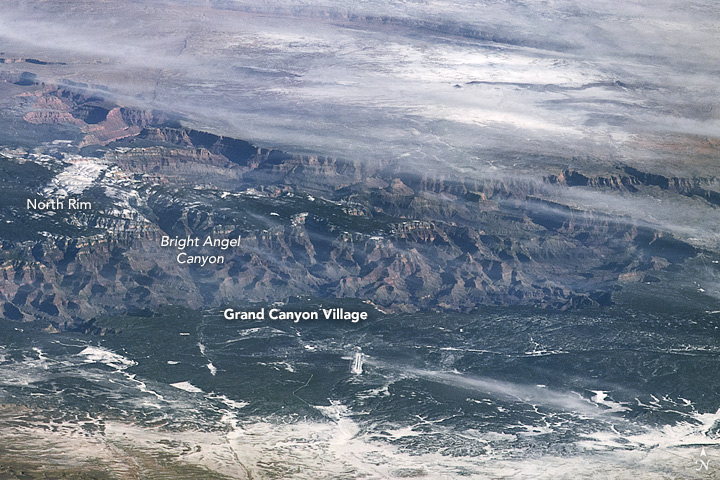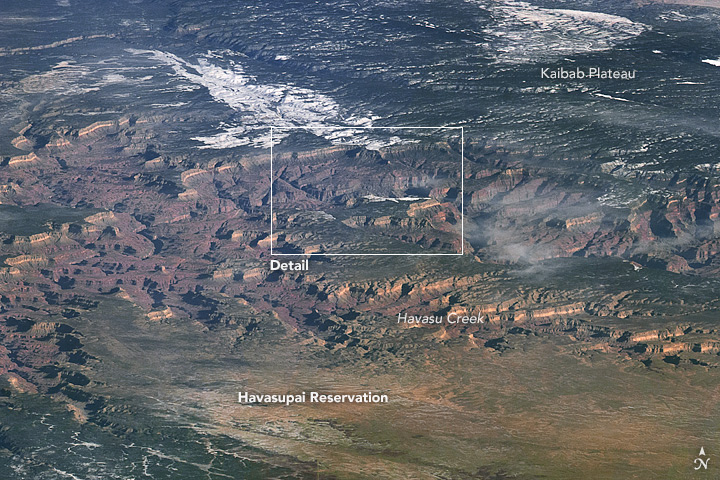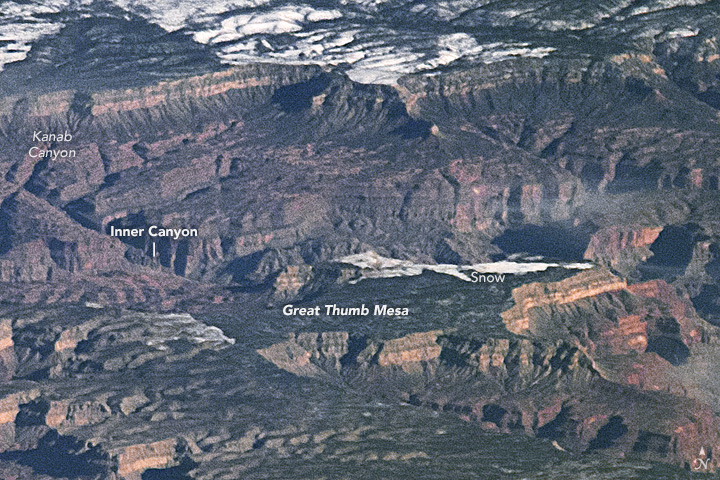


“If you want to see the whole canyon at once, an airplane won’t do. You have to be in orbit. I would highly recommend the International Space Station, if you have the chance.” —Marker Marshall, U.S. National Park Service ranger at the Grand Canyon
Grand Canyon National Park stretches 277 river miles (446 kilometers) across the Colorado Plateau of northwestern Arizona, and it averages 10 miles (16 kilometers) wide. But it is not just that spectacular size that makes it a natural wonder. It is the spectacular variety of ecosystems, micro-climates, and life forms that make it the grandest of canyons.
That variety arises out of the depth (or height) of the canyon. From the highest point on the Kaibab Plateau of the North Rim to the water line of the Colorado River, the elevation changes by 8,000 feet (2400 meters). According to the National Park Service (NPS), at least 129 different vegetation communities are found in the park at various altitudes. The dominant ones are the riparian (river) community; desert scrub; pine and juniper woodland; Ponderosa pine forest; and montane meadows and subalpine grasslands. Or as NPS puts it, you can wander from the environmental equivalent of Mexico to that of Canada all within a few miles.
More than 1,700 species of vascular plants—and another 400 of mosses, lichens, and fungi—populate these communities. At least a dozen plant species are only found only within the park. Those plants and trees give cover or food to 362 bird species, 92 species of mammals, and 59 types of reptiles and amphibians. This abundant life spreads across a landscape that is geologically abundant too, offering a rock and fossil record that spans three eras of geologic time. Six million years of erosion by the Colorado River has exposed two billion years of Earth history.
The photographs above and below were shot from the International Space Station (ISS) on December 18, 2009, by astronaut Jeff Williams. “It was a quiet period aboard the Station, with only two of us—Russian cosmonaut Max Suraev and me,” Williams recalls. “Using a Nikon D2Xs with an 800mm lens—and looking through one of the windows in the Russian docking compartment—I found the Canyon through mostly clear skies. I quickly fired off multiple overlapping frames with the idea to later merge the oblique shots.” The mosaic above was composed from 12 of those photographs. (Click on the link below it to download a full-resolution version.) The other photos are closeups derived from the wider shot.


Williams and the ISS were 650 miles (1050 kilometers) to the southwest at the time, over the Pacific Ocean near Baja. He located the canyon while observing the jumble of wooded plateaus, mountains, and tan desert flats of the western United States. The near-midday sun of winter threw long shadows; combined with the highly oblique viewing angle, the light gives a strong three-dimensional sense that is marred by just a few streaks of cloud.
Grand Canyon is the second most visited national park in the United States, drawing 5.5 million visitors in 2015. The park will celebrate its 100th anniversary in 2019. The National Park Service itself is celebrating its centennial in 2016.
Astronaut photographs ISS022-E-14078 through ISS022-E-14087 were acquired on December 18, 2009, with a Nikon D2Xs digital camera using an 800 millimeter lens, and are provided by the ISS Crew Earth Observations Facility and the Earth Science and Remote Sensing Unit, Johnson Space Center. The image was taken by a member of the Expedition 22 crew. The image has been cropped and enhanced to improve contrast, and lens artifacts have been removed. Additional images taken by astronauts and cosmonauts can be viewed at the NASA/JSC Gateway to Astronaut Photography of Earth. Caption by Mike Carlowicz, NASA Earth Observatory, with assistance from M. Justin Wilkinson, Texas State U., Jacobs Contract at NASA-JSC.